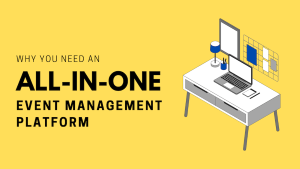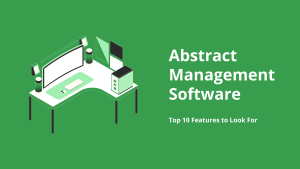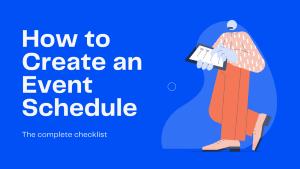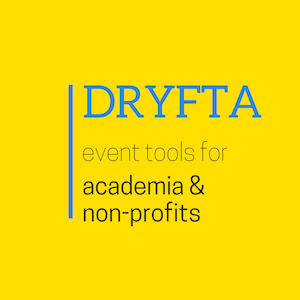
Whether physical or virtual, successful fundraising events are vital for any organization’s future. A well-promoted organization is more likely to receive help from its connections when needed, making it necessary to be known to the world.
Whether you’ve just started with the planning or near the event date, you need an effective marketing plan for nonprofit event promotion to get hooked with previous and new donors to make it a success.
Keeping in mind the financial limitations of nonprofit organizations, here we’ve created a list of 10 useful strategies for event promotion that are most likely to help you spread the word.
- Prepare event promotion budget beforehand
- Start event promotion early
- Understand donor segmentation for thoughtful event promotion
- Understand and provide alternate methods to join
- Use social media channels for upcoming nonprofit event promotion
- Make a hashtag strategy
- Special merchandise for conference promotion
- Word of mouth
- Active website content posting
- Conference promotion through email
10 Strategies for Nonprofit Event Promotion
1. Prepare Event Promotion Budget Beforehand
The first in our list of 10 strategies for nonprofit event promotion is budgeting. For nonprofit organizations, money is scarce yet the most important asset. It is important to understand your financial situation before making an actual event promotion plan.
You need to ensure the money you spend on promotion is extra and will leave no negative effect on the event or the organization if you lose it.
The easiest technique to understand your finances is to list all the needs and wants of the events. Needs are things you cannot carry out the event, such as furniture, transport, or decoration, whereas wants are those you can adjust to.
Make sure you don’t miss anything just because it seems too small to cost you money because sometimes the tiniest of things can add up to a great fortune.
Once you’re done with the list, calculate how much revenue you expect from the event. Once you’ve calculated your revenue, subtract the needs and wants to get the total you can spend on the conference promotion activities.
In case you’re wondering…
Creating a separate list of needs and wants will help you here. If the remaining budget seems too small to carry out successful event promotion, you can make some changes to the list of wants and check if you can save more for promotional activities.
If not…
Sponsorship from brands and individuals can be a great help. Remember, nonprofit events serve as a source of brand promotion; hence most advertisements and sponsors hunt for successful nonprofit events.
2. Start Event Promotion Early
One of the most commonly made mistakes by event promotion teams is poor time management. Fortunately, the key to the success of nonprofit events is early conference promotion. Generally, there’s no certified time, but it is said that starting promotions six months before the event yields the best results.
Meaning you should start with the promotional activities as soon as you’re done with the basic planning, i.e., date, venue, theme, and objective. You don’t need to share the micro details of the event like list, food, decoration, or ticket price right after promotion; it can work side by side with conference promotion.
Make sure the promotion continues till the event date, so people who have been following the promotion since the beginning don’t miss out.
3. Understand Donor Segmentation for Thoughtful Event Promotion
Marketing for nonprofit organizations works similarly to brand promotion. As brands need to understand and target their potential customers to make the most out of their marketing budget, you also need to design your nonprofit event promotion activities by understanding your audience and their segmentations.
Understanding your donor segmentation will help you reach out to your donors in the best means. Allowing your donors to donate and participate in the promotion in feasible ways. This will help you with prior fundraising and better promotion.
Start with understanding the general demographics of your target audience. You can understand this best through social media insights. Here, you’ll understand what type of people have reacted well to which content on specific social media channels. Understanding their previous activities will help you understand what strategy and content will work best for the conference promotion.
Following are the donor segmentation that will help you further.
- What means of communication are comfortable to your donors?
- Which donation channels do most donors use to send their donations?
- Who has attended your past fundraising events?
4. Understand And Provide Alternate Methods to Join
The more versatile the marketing, the greater the results. Your objective of the marketing is to get hooked with your current and potential donors to achieve the basic objective of the whole event.
Limiting your donors means losing the chance to get connected with people who might turn into a great help for your organization in the future. Hence, never limit your marketing by only focusing on the nonprofit event promotion but keep an element of versatility.
Make sure if your activities are reaching out to people who might not attend the event, they know how to connect with your organization in the present and future.
Volunteer Program: Some people believe that time is more valuable than money for nonprofit organizations, which is true to some extent. Make sure you have a volunteer sign-up method on all your channels so people can achieve a sense of personal connection with your organization which will be a win-win for both.
Corporate philanthropy: Not everyone in society is in a position to support the event financially. Educate such people through your marketing about what they can do for the event if they cannot participate financially or physically. This will create a sense of involvement in people.
5. Use Social Media Channels
The power of social media is not hidden. A good social media marketing plan and timely promotion can do wonders for your nonprofit event promotion. The best part of social media marketing is it works well with a limited budget.
If your nonprofit organization is not connecting with its potential audience through social media channels, you’re losing a chance to connect to a wider audience.
Various platforms and techniques work for different audiences regarding social media. Some of the social media platforms you can use for your conference promotion are follows.
Facebook: Facebook has 2.9 billion users worldwide. You will find people from all walks of life with different interests and hobbies on Facebook. The platform helps you connect with people sharing the same interests through advertisements, regular posting, and audience engagement.
Instagram: Instagram has around 1 billion users worldwide. Ideally, it is owned by meta, the owner of Facebook. Here hashtags and influencer marketing work great to spread word of mouth.
Twitter: Twitter is one of the most authentic and trusted social media platforms. Although it has significantly fewer users than the other two social media platforms, most influential people use it. Having an active Twitter account might help you connect with influential people in your genre.
6. Make A Hashtag Strategy
This strategy of conference promotion is somewhat connected with the previous one. Hashtags are a great way to spread important news or online event promotion. Creating a hashtag for your event is an organic way to connect with your supporters without involving money.
One way to promote your event hashtags is by encouraging your current supporters to use your hashtag on their social media platforms. Additionally, being creative with hashtag promotion is the best technique these days. It can be a picture, video, or a simple post with your organization’s hashtag.
7. Special Merchandise for Conference Promotion
When it comes to event promotion, you should consider maximum ways to connect with your audience. This technique works best for youth and those who are less active on social media. Additionally, having special merchandise for conference promotion helps you with two things at once, i.e., promoting the event and fundraising needed before the event.
It can be t-shirts, caps, hoodies, mugs, and keychains with your name printed or even your event’s hashtag. Knowing there’s a limited stock creates an urgency in supporters to purchase it.
8. Word Of Mouth
You may not have considered it an important aspect, but word of mouth can work wonders for nonprofit event promotion. Word of mouth is one of the oldest yet still effective techniques.
When people see their relatives, friends, or community getting excited about an event, there are more chances that they might start taking an interest in the promotional activities also.
You can apply this strategy by involving influential groups, individuals, and communities in your promotional activities. Make your volunteers, supporters, and members create excitement about your event. Engage maximum people in your promotional activities to create hype for the event.
9. Active Website Content Posting
Having a website for your organization will develop a sense of authenticity in your current and potential supporters; hence don’t miss out on this one. Your website can work as a central place where all your supporters, donors, and volunteers can land for authentic information and event updates.
Creating a separate page for your conference promotion is a good idea. Think of content that your audience will find interesting and regularly with content publication.
Don’t forget to add a call to action on your landing page. It creates an urgency in the visitor to take your desired action, eventually helping you capture your potential audience better.
10. Conference Promotion Through Email
Email marketing is considered more professional when it comes to nonprofit event promotion. Although there are some technicalities involved in email marketing, such as time, content, or the number of emails you are sending, it is still a less expensive yet effective source to promote your upcoming event.
A great strategy that works most of the time with email marketing is dividing it into three categories.
Save the date email: This will work as the first promotional email for your audience. Here you’ll focus on informing maximum people about the event, its objective, and other details like location, activities, or guest speakers.
A follow-up email: Send a follow-up email 2 to 3 weeks before the event as a reminder or update. Educate your audience with more specific details and engage them by sharing the new developments.
Call to action email: This will work as a full and final email for your event. It is recommended to send it one week before the event to create urgency and excitement in your audience to attend the event. Show them the benefits of joining while leading them to your main website, where they can purchase tickets or register themselves.
Final Verdict
Creativity is the key to successful promotion. There are countless methods to promote your event. Carefully evaluate all your means to connect with maximum people who can make your event a success by attending it. We hope our nonprofit event promotions strategies for 2022 will help you make a change.





